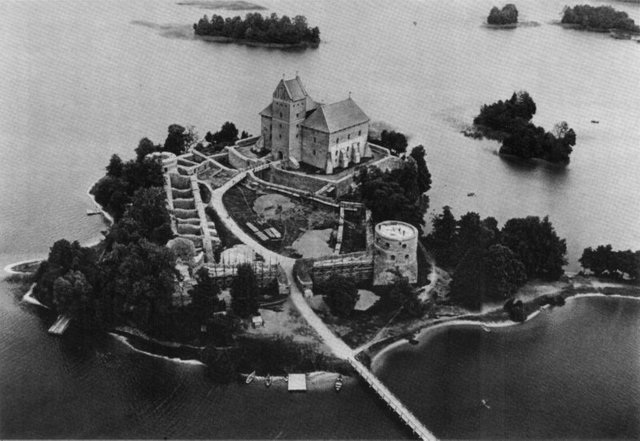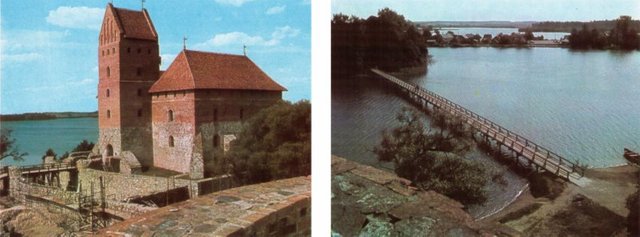Trakai (featuring Vasily Peskov as author)
If a person visits Lithuania and is interested in the Republic and its history he will certainly find his way to Trakai, which is only an hour's ride from Vilnius.
The picturesque roads of Lithuania pass through hilly country, meadows, groves and lakes both large and small. However, there is more to please the eye than the beautiful countryside, for there are also many landmarks of times long past. Trakai occupies a place of honor among them.

I first saw it from above. All during our approach I could not take my eyes from the turquoise water, the green tufts of islands that were like green clouds and the castle-fortress of red brick and white stone.
A long bridge leads here from the mainland. Once, long, long ago, water filled the moat around the castle. At sunset, or whenever an enemy was sighted, the bridges were raised and the castle became a fortress. The Chronicles, the stone cannon balls and arrowheads which are still found on the island are witnesses to the sieges laid by the Crusaders. Though the Invaders pillaged and razed the lands all around, the fortress stood its ground. Cannon balls, a hail of arrows and hot tar poured down on the enemy from the loopholes. Many a tooth was broken on this hard nut. Still, there came a time when the fortress surrendered. One can imagine the long siege. Smoke drifted over the lake. Then one day the Crusaders set off in boats under cover of the smoke and attacked the castle. They left it in ruins.

But the fortress on the island rose again, for Trakai was the ancient capital of Lithuania, and the castle was the seat of its grand dukes. When Vilnius later became the capital the forsaken castle was turned into a prison. In the end, its narrow, winding staircases, echoing halls, rafters and loopholes were given over to an army of bats. As always, time was unkind to the structures that had stood their ground for five hundred years. The towers, the castle and the walls were reduced to rubble. Yet, this spot on Lake Galve means so much to every Lithuanian that it was decided to restore the ancient landmark. Historians, restorers, masons and carpenters put all their efforts into the project. The name "Trakai" came to be known far and wide. Each summer the resurrected castle is stormed anew, but no one locks the gate or raises the bridge any longer. Instead, the keepers say "Welcome!" to two hundred thousand visitors a year. When work was first begun there was much talk of the cost of the project. However, the ten-kopeck entrance fee has covered the initial investment. Though work is still in progress, the beauty of this ancient Lithuanian landmark is already apparent.
When flying over the area you see round hills criss-crossed by strips of yellow wheat and clumps of wood, with lakes scattered here and there among the hills. Suddenly you catch sight of a chain of lakes dotted with nearly two dozen small, green-tufted islands. One of them is crowned by a red-and-white fortress. Here, indeed, is a rare combination of antiquity and unspoiled nature.